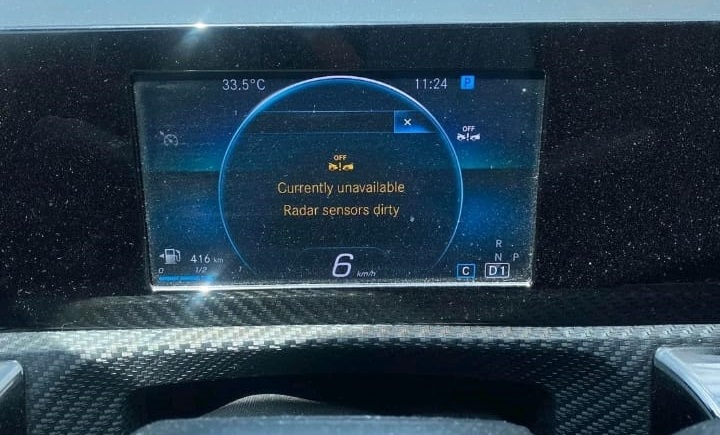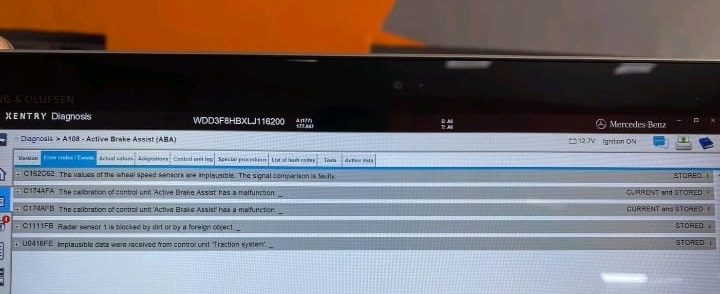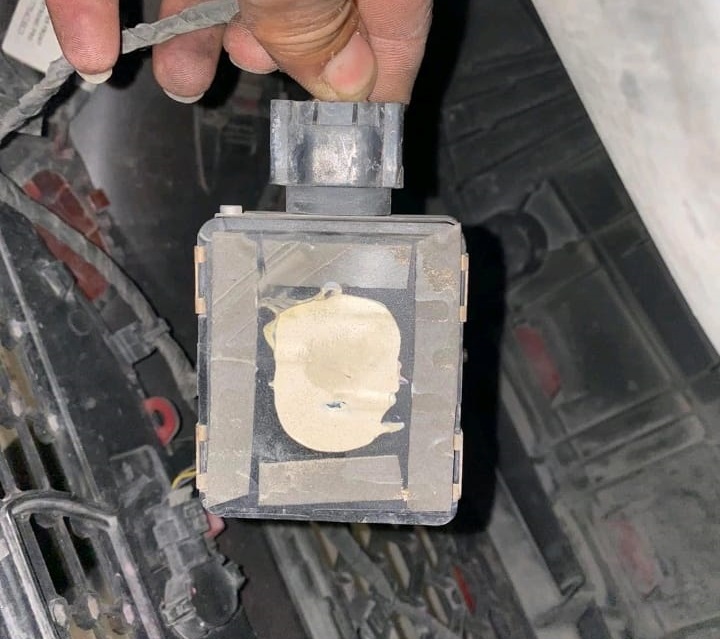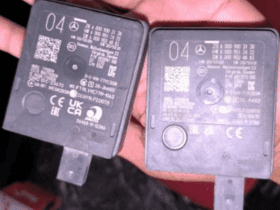Table of Contents
Mercedes Radar Sensor Dirty : Why It Appears & How to Fix It
Modern Mercedes-Benz vehicles rely on radar-based driver assistance systems to enhance safety and comfort. When a “Radar Sensor Dirty” warning appears on your dashboard, it indicates that critical systems such as Active Brake Assist, Park Assist Mercedes, or Blind Spot Assist may be temporarily unavailable.
This fault is one of the most common issues covered in our main hub
Mercedes Driver Assistance System Faults: Radar, Blind Spot & Parktronic Fixes which explains how radar, ultrasonic, and camera sensors interact across the ADAS network and how to diagnose faults effectively.
What Does “Radar Sensor Dirty” Mean?
This warning signifies that the radar sensor responsible for detecting objects ahead is blocked, dirty, or misaligned. The radar unit mounted behind the front bumper or grille emits radio waves that must travel unobstructed to detect vehicles, obstacles, or pedestrians.
When mud, snow, road grime, or even wax residue accumulates on the bumper, the sensor’s readings become inaccurate, prompting the system to deactivate key ADAS functions temporarily.
In short: “Radar Sensor Dirty” means your Mercedes’ safety systems can’t see properly a problem that’s often easy to fix, but critical not to ignore.
Common Causes and How to Identify Them
| Cause | Driver Symptoms | Check / Diagnosis |
|---|---|---|
| Road grime, mud, bugs, rain | Warning appears during driving; ADAS disabled | Inspect front grille and bumper for dirt or debris |
| Snow or ice buildup | Warning during cold weather | Gently remove ice; recheck after thawing |
| Sensor misalignment or damage | Warning persists post-cleaning | Visual check and diagnostic scan; inspect mounting bracket |
| Software glitch | Warning remains after cleaning | Reset ignition, clear codes, or update control unit firmware |
How to Clean & Restore Sensor Function
- 1. Locate the radar sensor; usually behind the front grille or bumper (see image below).
- 2. Turn off your vehicle to prevent system interference.
- 3. Clean the sensor area with a soft microfiber cloth and mild soap solution no high-pressure water.
- 4. Dry completely to prevent false readings.
- 5. Restart your Mercedes and verify if the warning disappears.
If the message remains, a deeper inspection is necessary to verify sensor alignment, wiring integrity, or calibration status.
DIY vs Professional Fix
| Action | DIY Possible? | Professional Needed? |
|---|---|---|
| Clean sensor lens | Yes | No |
| Remove debris or ice | Yes | No |
| Inspect for physical damage | Yes | No |
| Reset system / ignition cycle | Yes | No |
| Sensor alignment check | Partial | Recommended |
| Full diagnostic scan | Optional | Essential if warning persists |
| Sensor replacement | No | Required if cracked or misaligned |
Case Study N*1: Radar Sensor Dirty Message on Mercedes-Benz CLA W118
Customer Complaint
The owner of a Mercedes-Benz CLA W118 visited our workshop after noticing the warning message “Radar Sensor Dirty” appearing on the instrument cluster shortly after replacing the front bumper with an AMG-style version. The customer reported that before the modification, all driver assistance features including Active Brake Assist and Adaptive Cruise Control were operating flawlessly.

Initial Observation
The vehicle had recently undergone cosmetic upgrades, including the installation of a new AMG front bumper, chosen for its sportier design. However, following the modification, the radar-based systems suddenly became inoperative. This unexpected fault raised concerns about a potential sensor obstruction or misalignment caused during the bodywork process.

Even though the new AMG bumper enhanced the car’s aesthetics, it unintentionally disrupted the radar sensor’s visibility a reminder that external modifications can directly impact the performance of advanced driver-assistance systems (ADAS).
Diagnostic Procedure
To identify the root cause, a complete diagnostic scan was performed using the Mercedes-Benz XENTRY diagnostic system.
The following fault codes were retrieved from the Active Brake Assist (ABA) control unit:
- – C163691 : Front radar sensor calibration fault
- – B182700 : Control unit coding incomplete
These codes confirmed that the radar sensor signal was out of range, likely due to improper sensor positioning or mounting after bumper replacement.

A visual inspection was then carried out by removing the front bumper. The technician quickly discovered that the front radar sensor module (A108) was not correctly seated in its designated bracket. It had been installed at a slightly different angle, causing the radar beam to deflect incorrectly.
Root Cause
The issue was traced to improper sensor reinstallation during the bodywork process. The AMG bumper design required a specific mounting bracket orientation for the radar module, which differs slightly from the standard CLA bumper configuration. Because of this oversight, the radar’s line of sight was obstructed, triggering the “Radar Sensor Dirty” warning and deactivating several ADAS features.

Repair and Calibration
- 1. The radar sensor was reinstalled using the correct bracket position according to Mercedes-Benz factory specifications.
- 2. A radar calibration procedure was performed using XENTRY to realign the sensor’s detection field.
- 3. A short test confirmed all related fault codes were cleared.
- 4. The vehicle was then taken for a road test to verify the accuracy of radar-based functions such as Active Brake Assist and Collision Prevention Assist Plus.
After these steps, the warning message disappeared, and all ADAS functions resumed normal operation.
Outcome and Lessons Learned
This case highlights how seemingly minor cosmetic modifications like bumper replacements can interfere with complex electronic systems. Proper sensor installation, calibration, and coding are critical to maintaining safety functionality.
Always ensure that radar, ultrasonic, and camera sensors are reinstalled and calibrated according to Mercedes-Benz specifications after any bodywork or paint job.
Technician Insight
The successful resolution of this issue reinforces a key diagnostic principle:
- – When a driver assistance warning appears immediately after body repair or modification, start with a visual inspection of sensor placement and alignment before suspecting electronic failure.
Thanks to a methodical approach, the radar system on this Mercedes-Benz CLA W118 was restored to full functionality giving the owner confidence once again in the reliability of their vehicle’s advanced safety systems.
Case Study N*2: Collision Avoidance System Failure During Heavy Rain
Customer Complaint
During routine road testing of a Mercedes-Benz A-Class W177, the driver reported a sudden dashboard warning:
“Currently Unavailable Radar Sensors Dirty”
The issue occurred while driving in heavy rain on the motorway, where visibility was poor and the adaptive safety systems disengaged. Although the warning cleared after a short period, the event raised concerns about the reliability of Active Brake Assist and Collision Prevention Assist Plus under adverse weather conditions.

Initial Assessment
The warning indicated that the front radar sensor had temporarily lost its ability to detect objects due to water accumulation or road spray. Modern radar sensors in Mercedes vehicles are designed to operate in all weather conditions, but when excessive rain, dirt, or snow obstructs their field of vision, the ADAS (Advanced Driver Assistance Systems) automatically deactivate for safety.
Given the potential implications for collision avoidance and liability, the workshop team decided to conduct a detailed diagnostic analysis.
Diagnostic Procedure
1. Fault Detection Using Autel MS906 Diagnostic Tool
A full system scan was performed using the Autel diagnostic tool. The scan revealed a stored fault code in the radar sensor control unit, corresponding to temporary radar blockage.
Freeze-frame data was retrieved, providing a snapshot of the vehicle’s parameters at the exact moment the fault was triggered.

2. Freeze-Frame Data Analysis
The recorded data included:
- – Vehicle speed: Above 90 km/h (motorway conditions)
- – Wiper status: Active
- – Accelerator and brake input: Normal driving
- – Environmental conditions: Heavy rain reported
By comparing the freeze-frame data with the driver’s account, the team confirmed that the fault occurred during heavy rain, correlating perfectly with the “Radar Sensor Dirty” warning displayed on the cluster.

Findings and Insights
Operational Impact
The stored fault code confirmed that the collision avoidance system was deactivated due to radar obstruction. Once the radar sensor’s field cleared, the system automatically reactivated though no specific timestamp was recorded for when normal operation resumed.
Safety and Legal Implications
This data is significant for accident investigation and driver accountability. If a collision were to occur during such an event, the stored fault code could serve as evidence that the radar-based safety systems were temporarily unavailable protecting both the driver and the manufacturer from false claims.
Even if the driver clears the warning or it disappears from the display, these faults remain archived in the ECU memory and can be retrieved through professional diagnostics.
Data Limitations
Freeze-frame data records the moment of failure but does not indicate when the system recovered. This gap can complicate crash reconstruction, particularly in regions where Crash Data Retrieval (CDR) systems are not supported.
In the UK, Mercedes-Benz models currently do not provide CDR access for pre-crash data, which makes freeze-frame and ECU data analysis crucial for post-incident verification.
Manufacturer Data Transmission
Modern Mercedes-Benz vehicles can transmit diagnostic and fault data to the manufacturer’s servers for quality control and legal traceability.
This means that if a customer claims their collision avoidance system failed to respond, Mercedes can reference remote fault records to verify whether the system was functioning or temporarily disabled due to sensor obstruction.
Repair and Follow-Up
After confirming no permanent radar damage, the technician:
- 1. Inspected the front radar sensor housing for water ingress or seal deterioration.
- 2. Cleaned and dried the front bumper area.
- 3. Cleared all fault codes from the control unit.
- 4. Performed a short test drive under moderate rain conditions to verify proper system operation.
The system operated normally, and no warnings reappeared.
Key Takeaways
This case underscores the importance of interpreting ADAS fault data correctly especially when warnings occur intermittently during environmental stress.
- – Heavy rain or mud can temporarily disable radar-based safety systems without indicating a hardware fault.
- – Stored freeze-frame data provides vital evidence for both technicians and investigators.
- – Professional diagnostic tools such as the Autel MS906 or XENTRY are essential for confirming fault conditions and timelines.
- – Regular cleaning and visual checks of radar sensor areas can prevent such warnings and ensure reliable ADAS performance.
For more detailed insight into similar Mercedes-Benz radar and sensor issues, visit our main guide:
Mercedes Driver Assistance System Faults: Radar, Blind Spot & Parktronic Fixes
Case Study: Front Radar Sensor Fault After Collision
Customer Complaint
A Mercedes-Benz A200 was brought into the workshop following a front-end collision repair. The owner reported that since the repair, several driver assistance features including Active Brake Assist and Collision Prevention Assist Plus were inactive, and the “Radar Sensor Malfunction” message appeared on the instrument cluster.
Initial Assessment
Visual inspection confirmed that the front radar sensor module had been physically damaged in the accident. The bumper had already been replaced, but the radar sensor’s internal mount appeared misaligned. The customer noted that despite replacing the sensor with an aftermarket part, the warning persisted, indicating deeper issues related to coding or calibration.

Diagnostic Procedure
1. Fault Code Reading
Using the AUTEL diagnostic tool, the technician performed a complete system scan. The following fault codes were stored in the Front Radar Sensor Control Unit (N62/1):
| Fault Code | Description |
|---|---|
| B220662 | The current Vehicle Identification Number (VIN) is incorrect or not present; signal comparison faulty. |
| C163691 | Calibration of the front radar sensor malfunction, parameter outside permissible range. |
| B182700 | Control unit coding incomplete or invalid. |
These codes suggested that while the new radar sensor was recognized by the network, it was not properly initialized or coded to match the vehicle’s configuration.

2. Analysis and Root Cause
The replacement radar sensor had been physically installed but not electronically commissioned.

Modern Mercedes-Benz radar units are integrated into the vehicle’s ADAS network through unique VIN encoding and control unit coding. Without these steps, the system cannot interpret or synchronize the radar data with other modules, such as the Steering Assistance, ESP, and Brake Assist control units.
Additionally, C163691 indicated that the radar’s calibration parameters were misaligned likely a result of the new bumper and sensor not being properly leveled.
Repair Procedure
To fully restore system functionality, the following three essential steps were carried out:
Step 1: VIN Programming
The new radar sensor was programmed with the vehicle’s VIN using the AUTEL diagnostic system. This process ensures that the control unit recognizes the correct configuration and communicates accurately across the CAN network.
Step 2: Control Unit Coding
After VIN matching, the radar control module was coded to synchronize with other ADAS systems, including the Active Brake Assist, ESP, and Pre-Safe functions. Coding validated the data communication protocols and re-established the link between the radar and the powertrain CAN bus.
Step 3: Radar Calibration
A radar calibration procedure was then performed using specialized alignment equipment. The technician positioned the calibration target board at the factory-specified distance and height, ensuring the radar beam angle was within acceptable tolerances. Once calibrated, all warning messages disappeared.
Verification and Results
After completing the three-step process:
- – All previously stored fault codes (B220662, C163691, B182700) were successfully cleared.
- – The radar sensor passed functional testing under both static and dynamic conditions.
- – A final road test confirmed that collision avoidance, adaptive braking, and distance control systems operated normally.
The repair was logged and validated as successful.
Technician Insight
This case demonstrates that replacing a radar sensor in a Mercedes-Benz vehicle is not a plug-and-play repair. Even when using an OEM part, programming, coding, and calibration are mandatory to ensure full ADAS functionality.
Installing the hardware without performing these electronic commissioning steps can lead to persistent warnings, ADAS deactivation, or incorrect distance measurement compromising both safety and customer confidence.
Key Takeaways
- – Always perform VIN programming, control unit coding, and radar calibration after replacing any radar module.
- – Verify all ADAS-related fault codes with OEM-level tools such as Mercedes XENTRY.
- – Avoid using non-genuine radar sensors, as aftermarket units may not support proper coding or calibration.
- – After any front-end repair, check radar alignment to maintain the accuracy of driver assistance systems.
Conclusion
The Mercedes-Benz A200 case highlights the complexity of radar-based systems in modern vehicles. With accurate diagnosis, OEM tools, and step-by-step calibration, the technician restored full functionality to the vehicle’s collision prevention system.
For more case studies and repair insights on similar ADAS issues, visit our comprehensive guide:
Mercedes Driver Assistance System Faults: Radar, Blind Spot & Parktronic Fixes
Owner Feedback
“After cleaning mine it cleared for a day, but then came back. Dealer found corrosion on the radar sensor plug had to replace the connector.”
— User on MBWorld.org
“After my bumper replacement, the radar was slightly off-angle. Dealer recalibrated it and fixed the issue.”
— Reddit user /r/mercedes_benz
Preventive Maintenance Tips
| Condition | Recommended Action |
|---|---|
| Heavy rain, mud, snow | Clean sensors after each drive in harsh conditions |
| After washing or detailing | Use microfiber cloth; avoid wax residue |
| After collision or bumper repair | Have sensors realigned and calibrated |
| Every service interval | Request radar and ADAS inspection during maintenance |
Where is the radar sensor Mercedes located?
Radar sensor Mercedes location
In most Mercedes-Benz compact models, the front radar sensor is mounted behind the lower front bumper, typically on the right side near the grille emblem, as you see in the image below.

Step-by-Step: Clean & Restore Sensor Function
- – Turn off the car and park in a shaded, calm area.
- – Locate sensors typically behind front grille/bumpers or near windscreen/star emblem.
- – Clean gently with a microfibre cloth, warm water + mild soap avoid pressure washers.
- – Remove ice or debris carefully, without prying off sensors or covers.
- – Dry thoroughly, then restart the car and check if the message disappears.
- – Soft reset not solving it? Re-scan ADAS system via dealer tools or update firmware
How to replace radar sensor in Mercedes CLA and A-CLass ?
you can replace the Mercedes A Class W177 and CLA 118 radar sensor by following the following steps;

- 1. Remove the front bumper and place it on a suitable support.
- 2. Unlock and disconnect the electrical connector from radar sensor (A108).
- 3. Unhook radar sensor (A108) from the mounting bracket and remove it from the support (1).
- 4. Commission the radar sensor (A108).
- 5. Carry out the calibration of the radar sensor (A108).
Key Takeaway
A “Radar Sensor Dirty” message may seem minor, but it affects safety-critical ADAS systems. Whether caused by dirt, misalignment, or sensor failure, prompt diagnosis and recalibration restore full system reliability.
For in-depth ADAS troubleshooting guides, explore our full coverage hub:
Mercedes Driver Assistance System Faults: Radar, Blind Spot & Parktronic Fixes
Author Bio
Written by Mercedes Expert
With years of hands-on experience diagnosing and repairing Mercedes-Benz systems, he brings technical depth and practical case studies to help car owners, technicians, and enthusiasts troubleshoot complex automotive issues. His work focuses on clear repair guides, OEM-level procedures, and knowledge-sharing to empower both professionals and drivers.
Last update: November 2025
— Salim, Mercedes Expert
Independent specialist in Mercedes-Benz diagnostics, CAN Bus analysis, troubleshooting case studies, and EV systems.







Leave a Reply